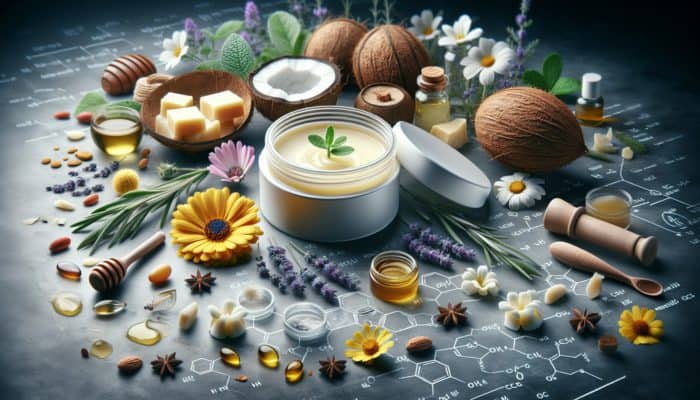Discover the Remarkable Benefits of Herbal Balms for Skin Care Across the UK
Unlock the Healing Powers of Herbal Balms for Your Skin

Herbal balms represent a collection of natural, topical formulations meticulously crafted to soothe, heal, and rejuvenate the skin with impressive effectiveness. In the UK, these products are particularly esteemed for their remarkable capacity to treat cracked skin, providing not just temporary relief but long-lasting benefits. Utilising a unique blend of botanicals, herbal balms promote healing while ensuring the skin remains adequately moisturised and nourished. Some key ingredients often found in UK herbal balms include:
- Beeswax – Serves as a protective barrier, shielding the skin from harsh environmental factors.
- Shea Butter – Deeply hydrates and nourishes, enhancing the skin's softness and texture.
- Calendula – Renowned for its potent anti-inflammatory and healing properties, making it ideal for skin recovery.
- Lavender Oil – Not only provides calming effects but also supports skin regeneration and repair.
- Tea Tree Oil – Offers powerful antimicrobial properties, assisting in the prevention of infections in compromised skin areas.
- Chamomile – Effectively calms irritation while promoting a soothing sensation on the skin.
- Coconut Oil – Widely known for its exceptional moisturising properties and effectiveness against dryness.
- Jojoba Oil – Mimics the skin's natural oils, thus enhancing overall hydration and balance.
These carefully selected ingredients work synergistically to provide effective relief from the discomfort associated with cracked skin, establishing herbal balms as a staple in numerous UK households.
Explore the Rich Historical Context of Herbal Remedies in the UK
The practice of using herbal remedies in the UK has a rich and extensive history, tracing back to ancient civilisations. From the medieval period onwards, herbs were primarily valued for their medicinal properties, often cultivated in the gardens of apothecaries and households alike. This enduring tradition continues robustly today, as modern herbal balms seamlessly blend ancient wisdom with contemporary scientific understanding. Historic herbs commonly utilised for skincare in the UK include:
- Comfrey – Historically recognised for its skin-healing capabilities, particularly in wound care.
- Lady's Mantle – Utilised for its astringent qualities, beneficial for enhancing skin tone and texture.
- Marshmallow Root – Renowned for its soothing and protective effects on irritated skin.
- Plantain – Highly regarded for its ability to repair damaged skin effectively and promote healing.
- Thyme – Valued for its antiseptic properties, which contribute positively to overall skin health.
- Yarrow – Historically acclaimed for its wound-healing capabilities, often used in traditional remedies.
- St. John's Wort – Utilised to alleviate skin irritations and reduce inflammation effectively.
- Nettle – Recognised for its rejuvenating properties that promote skin vitality and health.
This rich heritage underscores the effectiveness of herbal balms today, bridging the gap between traditional practices and modern treatments to ensure optimal skin health and rejuvenation.
Discover the Top Herbal Balms Dominating the UK Market
The UK market is home to a diverse array of herbal balms, each specifically crafted to address various skin concerns, particularly the challenge of cracked skin. Among the most sought-after products are:
- Burts Bees Res-Q Ointment – Combines a unique blend of natural ingredients to provide effective relief for dry, damaged skin.
- Weleda Skin Food – A rich, nourishing balm that delivers intense moisture and revitalisation for dry and parched skin.
- Neal’s Yard Remedies Wild Rose Beauty Balm – Celebrated for its hydrating and restorative properties, making it suitable for all skin types.
- Badger Balm – A versatile balm that excels in treating both dry and cracked skin, offering profound moisture.
- Heel Balm by Kerasal – Specifically designed to address and repair cracked heels effectively, restoring softness.
- Herbivore Botanicals Moon Fruit Superfruit Night Treatment – Enriched with a variety of botanicals to rejuvenate skin overnight.
- Dr. Organic Manuka Honey Skin Lotion – Merges the healing properties of manuka honey with other natural ingredients for enhanced skin health.
- Purepotions Skin Salvation – A popular choice known for its natural formulation and effectiveness on severely dry skin.
These products are typically available at local pharmacies, health food stores, and online retailers, ensuring accessibility for anyone seeking effective relief from cracked skin.
How Do Herbal Balms Promote the Healing Process for Cracked Skin?

Comprehending the Mechanisms of Herbal Balms in Skin Healing
Herbal balms effectively facilitate the healing of cracked skin through various mechanisms of action. Primarily, they provide essential moisture, nutrients, and protective barriers that significantly aid skin recovery. The combination of natural oils and waxes forms an occlusive layer that traps moisture, effectively preventing further dehydration and promoting a hydrated environment. Additionally, many herbal ingredients possess vital anti-inflammatory and antimicrobial properties that are essential for skin healing. For instance, anti-inflammatory agents help alleviate redness and swelling, while antimicrobial components protect against potential infections in compromised areas of the skin.
When applied consistently, these balms significantly improve the overall functionality of the skin barrier, which is crucial for maintaining healthy skin. The soothing properties of various herbs, such as calendula and chamomile, support the skin’s natural healing processes, promoting quicker recovery from damage. By ensuring that the skin remains hydrated and protected, herbal balms substantially reduce the likelihood of further cracking and irritation, thus enhancing overall skin health.
What Natural Ingredients Are Most Potent for Healing Cracked Skin?
Several natural ingredients found in herbal balms have been identified as particularly effective for healing cracked skin. These components are often backed by both historical usage and contemporary scientific research. Key ingredients recognised for their healing properties include:
- Shea Butter – Celebrated for its deep moisturising capabilities and high-fat content, which nourishes dry skin effectively.
- Calendula – Its anti-inflammatory properties make it a crucial ingredient for soothing irritated skin and aiding healing.
- Beeswax – Forms a protective barrier that retains moisture while allowing the skin to breathe freely.
- Tea Tree Oil – Provides essential antimicrobial benefits, preventing infections in cracked areas of skin.
- Coconut Oil – Renowned for its hydrating properties and ability to heal various skin conditions, including dryness.
- Lavender Oil – Recognised for its calming scent as well as its capacity to promote skin regeneration.
- Chamomile – Utilised for its soothing effects, making it ideal for sensitive skin prone to irritation.
- Jojoba Oil – Mimics the skin's natural oils, enhancing moisture levels and promoting healing effectively.
By choosing herbal balms rich in these effective ingredients, individuals can successfully tackle the challenges posed by cracked skin, ensuring both immediate relief and long-term care.
What Application Techniques Maximise the Effectiveness of Herbal Balms?
To achieve optimal results from herbal balms, it is essential to understand proper application techniques. First and foremost, ensure that the skin is clean and dry before application. This critical preparation allows the active ingredients to penetrate effectively. For optimal outcomes, consider these techniques:
- Warm the Balm: Rub the balm between your fingers to soften it before applying, which enhances its spreadability and absorption.
- Apply Generously: Use a sufficient amount of balm to fully cover the affected area, ensuring adequate treatment and protection.
- Massage Gently: Utilize circular motions to work the balm into the skin, improving absorption and overall effectiveness.
- Reapply Regularly: For maximum efficacy, reapply every few hours, especially after washing hands or exposure to water.
- Focus on Problem Areas: Pay extra attention to particularly dry or cracked patches for targeted treatment, ensuring swift and effective healing.
- Use Overnight: Apply a thicker layer before bed to allow for enhanced overnight healing while you sleep, as the skin regenerates.
By adhering to these techniques, users can significantly enhance the healing process, leading to smoother, healthier skin over time, while also ensuring that the benefits of the herbal balm are fully realised.
Expert Insights on the Effectiveness of Herbal Balms for Cracked Skin
What Real-Life Examples Highlight the Success of Herbal Balms?
Numerous UK dermatologists and herbalists have shared compelling examples of the effective use of herbal balms for treating cracked skin. One notable case involved a middle-aged patient who experienced persistent cracking on her hands due to frequent washing and exposure to harsh environmental conditions. After integrating a calendula-infused herbal balm into her daily routine, she observed remarkable improvements within just one week. The balm's anti-inflammatory properties helped reduce swelling, while its moisturising elements successfully restored her skin's barrier function to a healthy state.
Another example features a young athlete who suffered from cracked skin on her feet due to prolonged wear of tight shoes. She opted for a balm enriched with tea tree oil and coconut oil, which not only facilitated healing but also prevented infections. Her experience exemplifies how herbal balms can be both effective and safe alternatives to harsher treatments. These real-world applications underline the growing trust in herbal remedies, reinforced by personal testimonials and expert endorsements.
What Expert Recommendations Should You Follow for Effective Usage?
Experts in the UK recommend selecting specific herbal balms based on individual skin type and the severity of the condition. Dermatologists often advise balms containing shea butter and calendula for dry and sensitive skin, while those dealing with fungal issues may benefit from tea tree oil-based formulations. Conducting a patch test before full application is also prudent to ensure no adverse reactions occur, which is crucial for safety.
In terms of usage guidelines, experts recommend applying the balm generously to affected areas at least twice daily, particularly after washing hands or taking a shower, as this maximises hydration and healing potential. Additionally, using the balm at night can enhance its healing properties since the skin tends to absorb moisture and nutrients more effectively during sleep. Following these expert recommendations can lead to improved skin resilience and overall comfort.
What Steps Should I Take to Choose the Right Balm for My Needs?
Choosing the right herbal balm can be challenging, given the vast array of options available. UK experts provide several actionable steps to simplify the selection process:
- Identify Skin Type: Determine if your skin is oily, dry, or sensitive to select a balm that meets your specific needs and preferences.
- Check Ingredients: Look for balms with trusted components such as shea butter, beeswax, and essential oils for effective results and skin compatibility.
- Read Reviews: Pay close attention to user feedback and ratings to gauge product effectiveness and overall user satisfaction.
- Consult Professionals: If uncertain, seek advice from a dermatologist or herbalist for tailored product recommendations based on your unique situation.
- Sample Products: Some brands offer sample sizes or travel packs, allowing you to test efficacy before committing to a full-sized product.
- Consider Allergies: Be mindful of any personal sensitivities to specific herbs or oils contained in the balm to avoid adverse reactions.
By following these steps, consumers can make informed choices that align with their unique skin needs, ensuring they fully benefit from the healing properties of herbal balms.
How Can I Recognise High-Quality Herbal Balms?
Recognising high-quality herbal balms is essential for achieving effective treatment outcomes. UK experts suggest several key indicators of quality. Firstly, scrutinise the ingredient list; high-quality balms typically contain a high percentage of natural, organic ingredients, devoid of fillers or harsh chemicals that may harm the skin. Certifications such as organic or cruelty-free also signify a reputable product that aligns with ethical standards.
Moreover, consider the manufacturer's reputation. Established brands with a history of producing safe and effective products tend to be more trustworthy. Consumer reviews on health blogs and online retailers can offer insights into user experiences and overall satisfaction. Be vigilant for any red flags, such as reports of adverse reactions, which may indicate lower product quality. By being thorough in your selection process, you can ensure that the herbal balm you choose is of the highest standard, promoting better skin health.
What Common Mistakes Should I Avoid When Using Herbal Balms?
Despite their many benefits, users often make common mistakes with herbal balms that can hinder their effectiveness. One frequent error is applying too little balm; a generous application is necessary to ensure that the active ingredients penetrate deeply into the skin for maximum benefit. Another common mistake involves failing to clean the skin properly before application, as dirt and oils can hinder the balm's optimal functionality and absorption.
Users also sometimes overlook the importance of consistency. Regular application is critical for achieving desired results, rather than relying on sporadic use. Additionally, some individuals may neglect to consider their skin type, opting for products that may not be suitable for their specific needs. Understanding these pitfalls is essential for maximising the benefits of herbal balms and ensuring lasting improvements in skin health.
What Notable Advantages Come from Using Herbal Balms in the UK?
Why Are Natural Ingredients Highly Valued in Herbal Balms?
Herbal balms in the UK are celebrated for their natural ingredients, making them a safe and effective choice for all skin types. Unlike many commercial products that are laden with synthetic chemicals and preservatives, herbal balms harness the power of nature to soothe and heal the skin. This reliance on natural components ensures that users are less likely to experience adverse reactions, making herbal balms suitable even for sensitive skin.
Many users appreciate the gentle, nurturing qualities of herbal ingredients like calendula and chamomile, which are well-known for their skin-soothing properties. Moreover, as consumers increasingly seek eco-friendly alternatives, the use of sustainably sourced herbs aligns with a growing trend towards environmentally conscious skincare. By opting for herbal balms, individuals can enjoy peace of mind, knowing they’re making a responsible choice for both their skin and the planet.
What Long-Term Benefits Can I Anticipate from Regular Use of Herbal Balms?
Consistent use of herbal balms can lead to significant long-term benefits for skin health. Users frequently report smoother, more resilient skin, as these balms work to repair and nourish the skin barrier over time. This healing process alleviates immediate issues like cracking while simultaneously helping to prevent future skin problems from arising.
Furthermore, many herbal ingredients have cumulative effects, meaning that the more consistently they are used, the better the skin condition becomes. For instance, users of shea butter and coconut oil-based balms often experience improved moisture retention and elasticity, contributing to a youthful and healthy appearance. By incorporating herbal balms as a regular part of a skincare regimen, individuals can achieve lasting results that enhance both the health and appearance of their skin.
How Do Herbal Balms Stand Up Cost-Wise Compared to Other Treatments?
Herbal balms are often more cost-effective than prescription treatments for cracked skin, making them an appealing option for many consumers. While high-quality herbal balms may carry a higher upfront cost than mass-produced commercial products, their natural ingredients and multi-functional benefits can lead to substantial savings over time. Many herbal balms serve multiple purposes, such as addressing dry skin, soothing burns, or even functioning as a lip balm, making them a versatile addition to any skincare routine.
Moreover, considering the frequent need for treatments for recurring skin conditions, herbal balms can help avoid costly dermatological visits and medications. Their availability in local pharmacies, health stores, and online ensures they remain accessible and affordable for all. With the added assurance of using natural ingredients, herbal balms represent a wise investment in long-term skin health and wellness.
What Proven Strategies Exist for Selecting the Right Herbal Balms for Cracked Skin?
How Can I Expertly Choose the Right Balm for My Needs?
Choosing the right herbal balm involves careful consideration of various factors. UK experts often highlight the importance of understanding ingredient quality. Seek balms that feature high concentrations of active botanical extracts rather than fillers or artificial additives. Additionally, it's essential to consider your skin's specific needs; for instance, those with sensitive skin may benefit from unscented or hypoallergenic formulas that minimise the risk of irritation.
Brand reputation is crucial as well. Opt for well-established brands known for their commitment to quality and transparency in ingredient sourcing. Checking user reviews and testimonials can provide valuable insights into a product's effectiveness and safety. Additionally, if possible, consult with a professional herbalist or dermatologist who can provide tailored recommendations based on individual skin types and concerns. By following these strategies, consumers can confidently select the best herbal balm for their skincare needs.
How Do I Effectively Incorporate Balms into My Daily Skincare Routine?
Integrating herbal balms into your daily skincare routine can significantly amplify their benefits. Start by applying the balm after cleansing, as this allows the skin to absorb moisture more effectively and enhances the healing process. For daytime use, apply a small amount to areas prone to dryness, such as elbows, knees, and hands, ensuring protection throughout the day against environmental stressors.
In the evening, consider applying a thicker layer as part of your nighttime routine. The skin naturally regenerates during sleep, making it an ideal time for healing agents to work. To maximise absorption, gently massage the balm into the skin until fully absorbed. Additionally, pairing the balm with a humidifier in dry environments can further support skin hydration. By consistently incorporating herbal balms into your routine, you can maintain optimal skin health even in challenging climates.
What Are the Best Practices for Storing Herbal Balms?
Proper storage of herbal balms is essential for maintaining their efficacy and ensuring they last. To ensure your balms remain effective, store them in a cool, dry place away from direct sunlight. Exposure to heat and light can degrade the quality of natural ingredients, thereby reducing their healing properties and effectiveness. Ideally, keep balms in their original containers to protect them from contamination and moisture.
Most herbal balms come with a shelf life indicated on the packaging, typically lasting from six months to two years, depending on the formulation. Pay close attention to expiration dates and discard any balms that have changed in consistency, colour, or scent. If your balm contains no preservatives, it may have a shorter shelf life, so regular use is encouraged. By following these best practices, you can ensure your herbal balms retain their potency and provide consistent relief for cracked skin.
Where Can You Find Quality Herbal Balms in the UK?
Which Local Pharmacies and Health Stores Stock the Best Herbal Balms?
Many local pharmacies and health stores throughout the UK offer a selection of herbal balms specifically formulated for cracked skin. These establishments often provide a curated range of reputable brands, allowing consumers the opportunity to ask questions and receive recommendations from knowledgeable staff. Chains like Boots, Holland & Barrett, and various independent health shops frequently carry well-regarded herbal products, ensuring easy access for customers seeking effective solutions.
Visiting local pharmacies allows customers to physically examine the products, read labels, and inquire about ingredients before making a purchase. Additionally, staff members can provide guidance on suitable options tailored to individual skin concerns. This personal interaction can be invaluable for those new to using herbal balms, as they may share insights into the most effective products for specific issues.
What Online Retailers Specialise in Natural Herbal Products?
Several online retailers in the UK focus on natural and herbal products, streamlining the process for consumers to find and purchase herbal balms for cracked skin. Websites like Amazon UK, Natural Life, and Herbal Haven offer extensive selections of balms with detailed product descriptions and customer reviews, assisting buyers in making informed choices.
Shopping online provides the convenience of comparing products and prices from the comfort of your own home. Many retailers also offer subscription services, enabling customers to receive their favourite balms regularly without the hassle of reordering. Furthermore, online platforms often provide access to exclusive deals and discounts, making it an economical option for those committed to using herbal balms long-term.
What Are the Best Deals and Discounts on Herbal Balms Currently Available?
Finding the best deals on herbal balms can save consumers considerable money. Many online retailers frequently offer special discounts, bundle deals, and promotional sales, particularly during seasonal events like Black Friday or Christmas. Subscribing to newsletters from herbal product retailers can also keep consumers informed about upcoming sales and exclusive offers that can lead to significant savings.
Local pharmacies may have loyalty programs or reward schemes that provide discounts on future purchases, encouraging repeat business and customer loyalty. Additionally, checking for coupons or online promo codes can further enhance savings. By being proactive in seeking discounts and deals, consumers can access high-quality herbal balms at more affordable prices, ensuring their skincare remains within budget.
Where Can I Discover Specialty Shops and Boutiques for Herbal Balms?
Specialty shops and boutiques across the UK often carry unique herbal balms that may not be available in larger retail outlets. These establishments provide a more personalised shopping experience, with knowledgeable staff who can offer expert advice on product selection tailored to individual needs. Many of these shops source their ingredients from local suppliers, ensuring that the balms are fresh and ethically produced.
Shopping at these boutiques allows customers to discover niche brands and artisanal products, often crafted with care and attention to detail. This not only supports local businesses but also promotes the use of high-quality, sustainable ingredients. Visiting specialty shops can also provide opportunities to sample products and learn about the benefits of various herbal ingredients, significantly enhancing the overall shopping experience.
Frequently Asked Questions about Herbal Balms
What Are the Primary Benefits of Using Herbal Balms for Cracked Skin?
Herbal balms offer numerous benefits for cracked skin, including effective moisturisation, anti-inflammatory properties, and protection from environmental irritants. They are formulated with natural ingredients, making them safe for all skin types, including sensitive skin.
How Frequently Should I Apply Herbal Balms for Optimal Results?
For the best results, it is recommended to apply herbal balms at least twice daily, particularly after washing hands or showering, to maintain skin hydration and facilitate healing effectively.
Are Herbal Balms Suitable for Sensitive Skin?
Yes, many herbal balms are formulated with gentle ingredients that are safe for sensitive skin. It’s advisable to perform a patch test prior to full application to ensure there are no adverse reactions, thereby ensuring safety and comfort.
Do Herbal Balms Have Any Side Effects Worth Noting?
Generally, herbal balms have minimal side effects, particularly if made from natural ingredients. However, some individuals may experience allergic reactions to specific herbs or oils, so caution is always recommended before use.
What Are the Proper Storage Guidelines for Herbal Balms?
Store herbal balms in a cool, dry place away from direct sunlight. Proper storage helps to maintain their effectiveness and prolongs their shelf life, ensuring consistent benefits.
Can Herbal Balms Address Other Skin Issues Beyond Cracked Skin?
Yes, many herbal balms can also be effective for additional skin issues such as eczema, psoriasis, and minor burns, thanks to their soothing and healing properties.
Where Can I Purchase Herbal Balms in the UK?
Herbal balms are widely available in local pharmacies, health food stores, online retailers, and specialty shops throughout the UK, ensuring accessibility for all consumers.
How Can I Determine if a Herbal Balm is High-Quality?
Look for balms that contain natural, organic ingredients, have positive customer reviews, and come from reputable brands. Checking for certifications can also indicate the quality of a product and its formulation.
Are Herbal Balms Safe for Use on Children?
Many herbal balms are safe for children; however, it is crucial to choose products specifically formulated for younger skin and consult a healthcare professional when uncertain about suitability.
What is the Average Price Range for Herbal Balms in the UK?
The cost of herbal balms varies depending on the brand and ingredients, but they typically range from £5 to £30, providing options for various budgets and preferences.
Connect with Us on Facebook!
The Article: Herbal Balms for Cracked Skin: UK’s Natural Remedy appeared first on https://mcrtherapies.co.uk
The Article Herbal Balms: The UK’s Natural Remedy for Cracked Skin Was Found On https://limitsofstrategy.com

